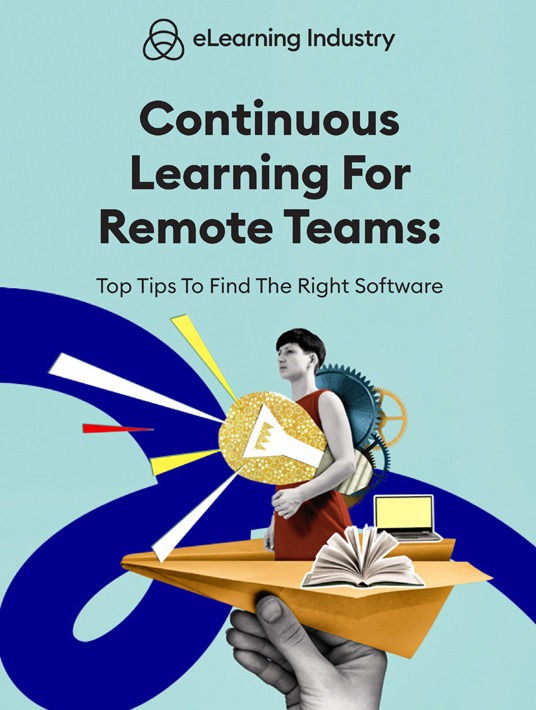
7 Tips For Continuous Learning On A Tight Budget
Necessity is thought to be invention’s mom. And when your SMB has a constrained development budget, you can only spend so much on employee training. This is no excuse for providing insufficient service or low-quality resources. You just have to find a way around your lack of cash. Is it possible to do so while still delivering superior, consistent training content to every member of the team, not just your new hires? These continuous learning best practices can help you support your staff and address workplace challenges on a limited budget.

eBook Release
Continuous Learning For Remote Teams: Top Tips To Find The Right Software
This guide will help you find the best software solutions for your telecommuting teams!
1. Start Small
At the beginning of your business undertaking, you may have a handful of staff members. They require just as much training as a corporate base of thousands. But you may not have the finances for it. This doesn’t mean you should “dumb down” your training. Just start where you’re at. Any fliers, web content, or even letterheads you produce should be recycled. These business materials can train staff on brand guidelines, design basics, and font selection. Reviewing corporate documents can help staff improve their written communication. Recording the founder at a meeting can guide junior staff on how to comport themselves and court investors.
2. Scale Based On Employee Needs
As your SMB grows, you can gradually expand your approach. For example, you may have started out digitizing and scanning written documents. After all, your team was small enough that you could ask each other questions in person. So, if anything was unclear, you could just tap in or out as needed. With a larger team, you can start to restructure those documents. Scanned contracts can now be repurposed as interactive charts with bullet points. Or a long introduction speech can be edited into mini quotes and cuts that display better on mobile. Your business entity is larger now, so spend a little more time and effort crafting your training content.
3. Repurpose What You Have
Makeover shows (and tiny-house programming) emphasize the importance of multitasking. But they apply the term in a more material manner. Meaning every item in your home (or piece of clothing in your closet) must have more than one function. A scarf can be a neck warmer, picnic blanket, or stain cover in case of monthly leaks. Similarly, any documentation at your company should be repurposed. Newsletters can be turned into discussion starters for your next live event. Televised pep talks can be replayed for periodic staff motivation. Old catalogs and manuals can be mined for troubleshooting tips and FAQ content.
4. Embrace The Power Of “Free”
Journalists often use Google alerts set for quirky phrases, whereby they get a notification whenever the target words appear. Many other experts use similar services, and you can apply this technique to your continuous learning platform. Aggregators can help you spot relevant videos, memes, or articles. And as long as they’re free and/or CCO, you can co-opt them into your course material. Be sure to attribute though—sharing is caring. And send the creator some coffee. At the very least, you’re able to link to notable guides, video clips, or articles that tie into your work tasks.
5. Launch A Peer-Coaching Group
Start a coaching group on social media (or one for every department) that allows employees to reach out and share their insights. They can even upload relevant resources or host live Q&As to address common challenges. One of the most cost-effective continuous learning best practices is using collaboration to broaden their knowledge. Once you launch the group, they’ll take it from there. Of course, you should have a moderator check in periodically to ensure the discussion is still on topic.
6. Let Employees Plot Their Path
Pre-assess your employees to see where they are now, then encourage them to set short- and long-term goals. In order to achieve them, they must figure out which courses, modules, or support resources they need to bridge gaps. For example, they should sign up for the management certification course because they eventually want to land the supervisor title. This also encourages them to take accountability for their own professional growth and chart their own career trajectory. They’re empowered to use continuous learning and LMS resources to discreetly address areas for improvement, as well as be on the lookout for emerging issues that stand in the way of their success.
7. Make A Continuous Learning Journal
It doesn’t have to be high-tech, complex, or even password-protected (unless you want it to be). Adding this bit to your continuous learning platform helps learners establish a mindset. Before they log out, have trainees type a few words describing what they’ve achieved. They can do this once a week or after each lesson. Bullet points are fine; you just want them to review their study in their own words. It helps content retention, verifies knowledge transfer, and gives them a reference point for training progress. It offers insights to your L&D team as well.
Conclusion
SMBs often have to settle for less than their ideal. Their financial resources don’t allow them to buy the best. But crunched cash doesn’t necessarily mean subpar training. By starting small, you can still train your growing team on a budget. Begin by repurposing existing content at no cost. Later, you can set aside funds to restructure content affordably. Newsletters and press releases can be reformatted. You can curate freely available blog posts, podcasts, and YouTube videos. Also, get trainees to summarize their learning in a journal and use peer collaboration to your advantage.
Our online directory features the top continuous LMS platforms for SMBs. Search by pricing model, use case, or deployment type to find the system that works best for your budget. You can also read the latest reviews to see what other small business owners have to say about your LMS of choice.
Download our eBook Continuous Learning For Remote Teams: Top Tips To Find The Right Software to extend training to every stage of the employee journey.
